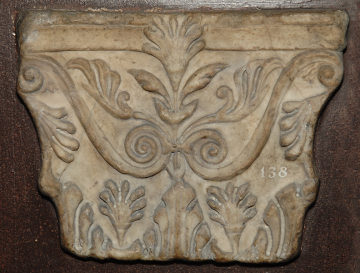Explore Collections


You are here:
CollectionsOnline
/
FRAGMENTARY COMPOSITE PILASTER CAPITAL
Browse
FRAGMENTARY COMPOSITE PILASTER CAPITAL
2nd century AD
Italian marble
Height: 22cm
Width: 28cm
Width: 28cm
Museum number: S138
On display: Study
All spaces are in No. 13 Lincoln's Inn Fields unless identified as in No. 12, Soane's first house.
For tours https://www.soane.org/your-visit
Curatorial note
This capital is enriched in the lower section with three stylised acanthus leaves between which are small palmettes. Two volute scrolls above reversed palmettes lead from the upper corners to a tied union with a triple foliate ornament at the centre. The foliate ornament terminates in a stylised palmette on the double moulding of the abacus.
This fragment is of second-rate work of the second century AD; there are few dated Imperial monuments in the capital from the reigns of Antoninus Pius, Aurelius and Commodus and therefore parallels are more deductive than readily citable. The somewhat lyre-shaped volute scrolls relate this capital to the group which has the Pantheon pilaster capital Soane M821 (Vermeule 61) as its turning point in the late Hadrianic and early Antonine periods.
Soane used this fragment as part of the decoration around the fireplace in his Study, setting it into the painted faux imperial porphyry plaster chimneypiece.
This fragment is of second-rate work of the second century AD; there are few dated Imperial monuments in the capital from the reigns of Antoninus Pius, Aurelius and Commodus and therefore parallels are more deductive than readily citable. The somewhat lyre-shaped volute scrolls relate this capital to the group which has the Pantheon pilaster capital Soane M821 (Vermeule 61) as its turning point in the late Hadrianic and early Antonine periods.
Soane used this fragment as part of the decoration around the fireplace in his Study, setting it into the painted faux imperial porphyry plaster chimneypiece.
Rome; collected in Rome by Charles Heathcote Tatham for the architect Henry Holland during the 1790s. See Cornelius Vermeule, unpublished catalogue of the Antiquities at Sir John Soane's Museum, Introduction, transcription of Tatham letters, List 1, no. 18.
Literature
Tatham: Etchings, 9; Drawings, 12.
Soane collections online is being continually updated. If you wish to find out more or if you have any further information about this object please contact us: worksofart@soane.org.uk


